In People Get Ready, musicians, scholars, and journalists write about jazz since 1965, the year that Curtis Mayfield composed the famous civil rights anthem that gives this collection its title. The contributors emphasize how the political consciousness that infused jazz in the 1960s and early 1970s has informed jazz in the years since then. They bring nuance to historical accounts of the avant-garde, the New Thing, Free Jazz, "non-idiomatic" improvisation, fusion, and other forms of jazz that have flourished since the 1960s, and they reveal the contemporary relevance of those musical practices. Many of the participants in the jazz scenes discussed are still active performers. A photographic essay captures some of them in candid moments before performances. Other pieces revise standard accounts of well-known jazz figures, such as Duke Ellington, and lesser-known musicians, including Jeanne Lee; delve into how money, class, space, and economics affect the performance of experimental music; and take up the question of how digital technology influences improvisation. People Get Ready offers a vision for the future of jazz based on an appreciation of the complexity of its past and the abundance of innovation in the present.
Contributors. Tamar Barzel, John Brackett, Douglas Ewart, Ajay Heble, Vijay Iyer, Thomas King, Tracy McMullen, Paul D. Miller/DJ Spooky, Nicole Mitchell, Roscoe Mitchell, Famoudou Don Moye, Aldon Lynn Nielsen, Eric Porter, Marc Ribot, Matana Roberts, Jaribu Shahid, Julie Dawn Smith, Wadada Leo Smith, Alan Stanbridge, John Szwed, Greg Tate, Scott Thomson, Rob Wallace, Ellen Waterman, Corey Wilkes
- Contents
- Acknowledgments
- Introduction “People Get Ready”: The Future of Jazz Is Now! by Ajay Heble and Rob Wallace
- Part I. Beyond Categories: Histories and Mysteries
- Chapter 1. “Now Is the Time”: Voicing against the Grain of Orality by Aldon Lynn Nielsen
- Chapter 2. The Antiquity of the Avant-Garde: A Meditation on a Comment by Duke Ellington by John Szwed
- Chapter 3. Listening Trust: The Everyday Politics of George Lewis’s “Dream Team” by Julie Dawn Smith and Ellen Waterman
- Chapter 4. Jeanne Lee’s Voice by Eric Porter
- Chapter 5. Kick Out the Jazz! by Rob Wallace
- Part II. Crisis in New Music? Vanishing Venues and the Future of Experimentalism
- Chapter 6. Days of Bread and Roses by Marc Ribot
- Chapter 7. Subsidy, Advocacy, Theory: Experimental Music in the Academy, in New York City, and Beyond by Tamar Barzel
- Chapter 8. Subsidizing the Experimental Muse: Rereading Ribot by John Brackett
- Chapter 9. One Musician Writes about Creative-Music Venues in Toronto by Scott Thomson
- Chapter 10. Somewhere There: Contemporary Music, Performance Spaces, and Cultural Policy by Alan Stanbridge
- Part III. Sound Check: The Jazz Photography of Thomas King
- Part IV. Get Ready: Jazz Futures
- Chapter 11. Black Jazz in the Digital Age by Greg Tate
- Chapter 12. Improvising Digital Culture by DJ Spooky and Vijay Iyer
- Chapter 13. Ancient to the Future: Celebrating Forty Years of the AACM by Douglas Ewart, Nicole Mitchell, Roscoe Mitchell, Famoudou Don Moye, Matana Roberts, Jaribu Shahid, Wadada Leo Smith, and Corey Wilkes
- Chapter 14. People, Don’t Get Ready: Improvisation, Democracy, and Hope by Tracy McMullen
- Works Cited
- Contributors
- Index

